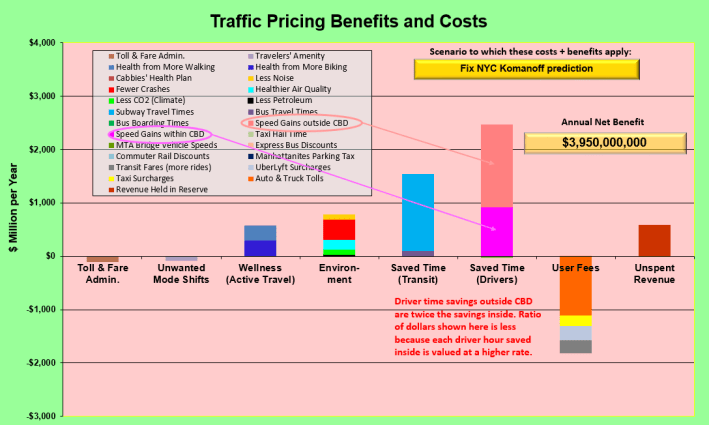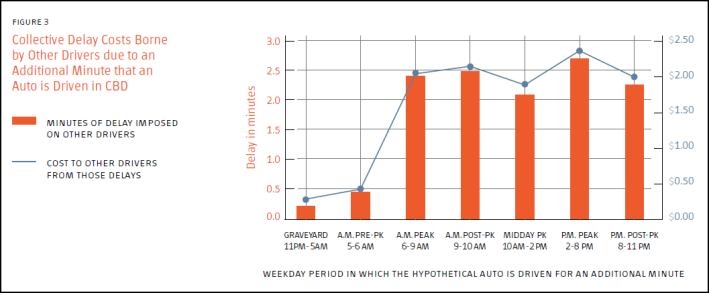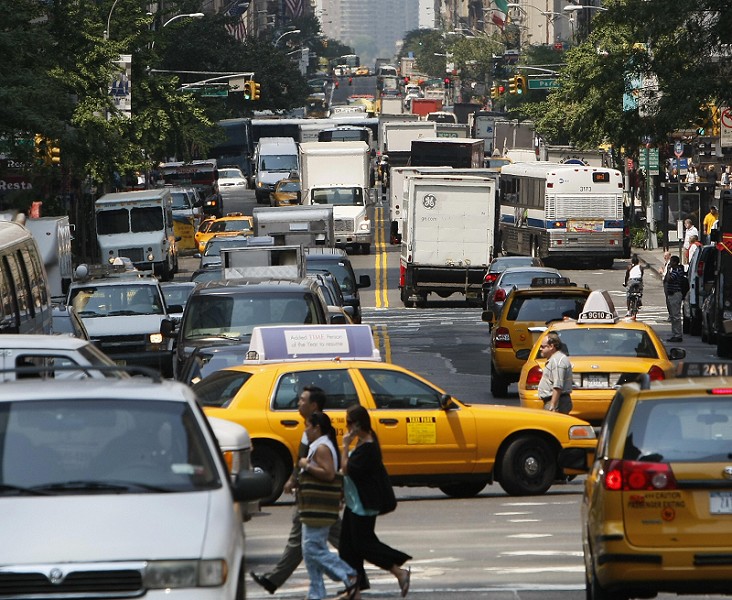
Tuesday's front-page New York Times story highlighting the spread of traffic outside Manhattan’s Central Business District is a good reminder that congestion pricing will likely save motorists twice as much travel time on streets and highways outside the CBD as inside.
Sure, travel speeds will increase more sharply in the CBD, percentage-wise — by an average of around 16 percent in Manhattan south of 60th Street, versus 10 percent on the roads that funnel cars and trucks into the congestion zone. But measured in hours saved, more than two-thirds of the reduction in gridlock will occur on the approach roads, with an average of 6,400 hours a day of saved vehicle users’ time outside the zone, vs. 3,000 hours a day inside.
(Mass transit users can expect to save another 10,000 hours a day, on average, as the mandated investment of 80 percent of congestion revenues in subway infrastructure yields more frequent and reliable train service.)
The upshot: reports of outer-borough gridlock like the Times story (which Streetsblog covered as far back as July 2020) don’t undercut the case for congestion pricing, they bolster it.
My quantitative findings may appear counter-intuitive. Let’s unpack them.
Q: Why will congestion pricing save more driver hours outside the CBD than inside?
A: Baseline driving volumes outside the Manhattan congestion zone dwarf volumes inside — by nearly 10 to 1. So even with a lesser percentage speed increase, congestion pricing’s saving in hours outside the CBD will overshadow the savings inside.

Think of it this way: When Sal from Sheepshead Bay or Sally from Scarsdale drive to the Manhattan core, they rack up a lot more miles getting to the CBD border than crawling around inside. Not only that, their nearby cousin or in-law who drives without going into the congestion zone will also save time with congestion pricing, since it will lighten traffic in Brooklyn and Westchester. (Getting these “free riders” to appreciate that congestion pricing is a pure win hasn’t been part of advocacy organizing; it should be.)
Q: Why is congestion pricing projected to improve CBD travel speeds by only 16 percent?
A: Mostly because for-hire vehicles make up half of motor vehicle volumes in the congestion zone (less than half during the 6 a.m.-8 p.m. peak when congestion is worst and the congestion charge is expected to be highest). If, as expected, FHV’s won’t have to pay the congestion toll, their presence acts as an enormous flywheel that dilutes the impact of the toll on cars and trucks.
Q: What do you mean, FHV’s won’t pay the congestion toll?
A: Remember, FHV’s already are assessed a congestion surcharge; since early 2019, any trip with a fare that touches the Manhattan taxi zone (up to 110th Street on the west side, 96th Street on the east) has been charged an extra $2.50 (for yellows) or $2.75 (for Uber and Lyft ride-hails).
The revenue from those fees, enacted by the state legislature in early 2018 — a year before passage of full congestion pricing — was supposed to jump-start outer-borough transit enhancements that would help CBD-bound drivers switch to buses or trains. Instead, in classic Cuomo fashion, they were blended with other MTA revenues — a ploy that may have helped stabilize fares, but at the cost of sowing cynicism about transit and congestion pricing.
Q: Haven’t you urged replacing the flat-fee surcharge on Ubers and yellows with a time-based charge?
A: Yes, most recently here, in October. Not only would time-based FHV congestion surcharging be more equitable and efficient than the current one-size-fits-all surcharge; it would also pioneer a more granulated form of congestion pricing that could be extended to e-commerce deliveries and, ultimately, all cars and trucks, not just in the CBD but in other gridlock-suffering parts of the city.
Whether our political system can grapple with this degree of complexity is an open question — as shown by outgoing Mayor de Blasio’s remarks about yellow taxis in a press availability earlier this week:
Yellow cabs are needed. They are part of our larger concept of mass transit in the city. They've been through a lot. ... We have to make sure that the taxi drivers of New York City, iconic part of the life of the city, are protected. So, let's exempt yellow cabs from congestion pricing, keep that part of our city strong, keep that part of our mass transit strong and focus on saying to folks it's no longer time to bring that single individual vehicle with one person in it. ... We don't want people coming in from all over the metropolitan area, one person in the car, driving into the city, in particular, Manhattan, creating a problem for everyone else. Let's get back to mass transit. Let's get back to cabs.
What, exactly, did the mayor mean? If he meant, “Don’t charge yellows a congestion entry fee on top of the congestion surcharge,” I’m with him all the way.
But if he meant, “Let’s wipe out the congestion surcharge and let yellow cab passengers impose massive, uncompensated congestion costs on every bus rider, cyclist, walker, and, yes, truck driver and motorist in Manhattan,” then, sadly, he has failed to learn the bedrock lesson of CBD congestion: that every minute a cab or other auto spends driving in the heart of Manhattan, from early morning into late evening, steals a collective two minutes from everyone else using the streets.

I guess it’s understandable that the lame-duck mayor who presided over the theft of the exclusive Manhattan taxi franchise by Silicon Valley venture capital — a giveaway that one of my Hunter College students has estimated extracted several times as much money from the yellow cab industry as the loan sharks who were fingered in that overblown 2019 New York Times series — would seek to throw a bone to struggling, salt-of-the-earth cabbies on his way out the door.
Not, however, at the expense of our fragile, precious commons — street space in the heart of the city. If the mayor truly wants to help the taxi industry, let him use his dwindling hours to throw his support behind my proposal to charge Uber and Lyft for their vehicles’ idle time in the taxi zone — a ready-to-go measure that will cut gridlock, generate revenue, combat economic inequality and help yellow cabs’ competitive position, in one stroke.
Charles Komanoff is a transportation, cab and carbon expert who frequently writes for Streetsblog. His admired archive is here.






